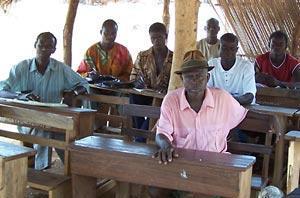Bogoŋ: a cultural, historical and linguistic documentation

Landing page image for the collection “Bogoŋ: a cultural, historical and linguistic documentation”. Click on image to access collection.
| Language | Bogoŋ |
| Depositor | Ulrich Kleinewillinghöfer |
| Affiliation | Gutenberg Universität, Germany; Bogoŋ Documentation Committee (permanent member), Ghana |
| Location | Ghana |
| Collection ID | 0040 |
| Grant ID | IPF0074 |
| Funding Body | ELDP |
| Collection Status | Collection online |
| Landing Page Handle | http://hdl.handle.net/2196/89ba15ff-7f19-4be9-b926-7208c1903f28 |
Group represented
Bogoŋ, Chala, Nawur.
Bogoŋ is spoken by the Chala people, a minority group living mainly to the east of the Oti River in the northern part of the Volta Region, in Ghana.In all but one of the five locations where the majority of the Chala reside as a distinct ethnic group, they find themselves in a minority position. In three settlements, Bogoŋ speakers are in an asymmetrical bilingual situation, speaking either Gikyode or Nawuri, the languages of the respective majority groups in public domains, and using Bogoŋ mainly at home, if at all. The high level of intermarriage with their neighbours is further responsible for the perpetual decline of the language. Thus the number of people of Chala ethnicity contrasts sharply with the number of people actually able to speak Bogoŋ fluently. Fluent Bogoŋ speakers probably number only several hundred. An unknown number of Chala are still found scattered in the central part of Togo and Benin. There they gave up their language long ago, though they have generally maintained their sense of Chala identity. The prospects of Bogoŋ appear particularly grim when considering the situation of the younger generation, the potential guarantors of the survival of the language. They are confronted with English, the official language of Ghana and the sole medium of instruction in secondary and higher education, and with Twi (Akan), the lingua franca of the region, as well as with the languages spoken by the majority groups (and their peers), with which they cohabit.
Language information
Bogoŋ, or Cala/Chala, is mainly spoken in a few settlements in the eastern part of central Ghana, in the Nkwanta District, in the northern part of the Volta Region, to the east of the Oti River. Bogoŋ is spoken by the Chala (spelled according to the Ghanaian orthography). Bogoŋ counts as a member of the Eastern Gurunsi languages. Eastern Gurunsi is one of the three branches of the Gurunsi (or Grusi) languages. The Gurunsi languages are a major subgroup of Central Gur or ‘voltaïque central’ (Manessy 1979, Naden 1989). The Gur languages are part of the North Volta-Congo branch within the Niger-Congo phylum (Williamson and Blench 2000).
Bogoŋ is severely endangered on account of several reasons:
- The speech community is small and fragmented and lacks a contiguous territory of its own.
- In all but one Chala settlement the Bogoŋ speakers are in the minority and use either Gikyode, Nawuri, Twi and/or English in public and often at home as well.
- There is only one village left where Bogoŋ is used in public and private domains. But even here, there are signs that the use of the lingua franca will soon take over some of the public domains.
- The high level of inter-marriage with their neighbours further boosts the perpetual decline of the ancestral language.
- Since Chala people are generally able to speak one of the neighbouring Guang languages, they have so far been overlooked by literacy campaigns, resulting in the lower status of their language compared to other languages in the district. This is especially serious for the younger generation who represent the future hope for the survival of the language. It may contribute to the evident tendency to give up the language in favour of Twi, English, or the more widely used Guang languages.
Collection contents
Valuable recordings, with transcriptions, including:
- the taboos of the Bogoŋ, explained by three of the most senior speakers: a former priest, the priest second to the chief priest and his wife
- stories and proverbs
- settlement of a dispute about the history of the clans on the West Bank of the Oti
- interviews recorded at Kpandai, 2006
The image shows members of the Bogoŋ Language Committee.
Many recordings focus on the environmental vocabulary, thus forming an excellent database for anyone who wants to know how the Bogoŋ interpret their environment linguistically. Related to it is the interpretation and discussion of Bogoŋ place names.
Acknowledgement and citation
To refer to any data from the collection, please cite as follows:
Kleinewillinghöfer, Ulrich. 2015. Bogoŋ: a cultural, historical and linguistic documentation. Endangered Languages Archive. Handle: http://hdl.handle.net/2196/00-0000-0000-0001-429C-7. Accessed on [insert date here].


